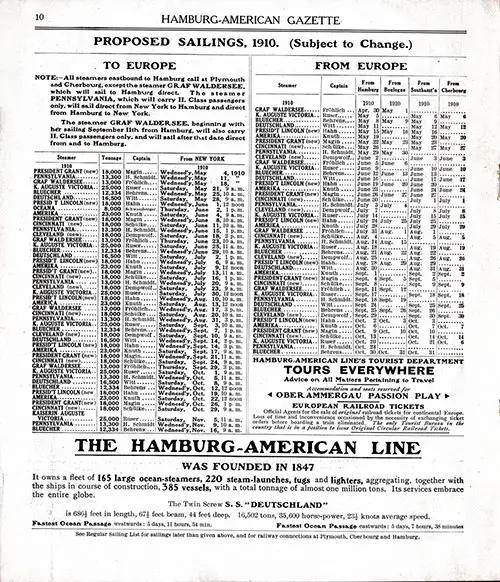SS President Grant Archival Collection
President Grant (1907) Hamburg-American Line
Built by Harland & Wolff, Ltd., Belfast, Ireland. Tonnage: 18,072. Dimensions: 599' x 68' (615' o.l.). Propulsion: Twin-screw, 14 1/2 knots. Quadruple expansion engines. Masts and Funnels: Six masts and one funnel. Ownership Change: Launched as the Servian, October 8, 1903, for Furness, Withy & Co., Ltd. However, before completion she was sold to Hamburg-American Line. They changed her name to President Grant. Maiden voyage: Hamburg- Plymouth-New York, September 14, 1907. Capacity: Accommodation for 200 first, 150 second and 3,000 third class. World War I Service: In service as a transport for the United States in World War I. Renamed: Republic (1924). Modifications: Reduced to four masts. World War II Service: Converted to troopship in World War II, and then to hospital ship. Fate: Scrapped in 1952. Sister ship: President Lincoln. Unusual Fact: Noted for being the only six-masted liners on the Atlantic.
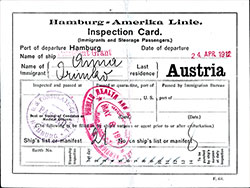
1912-04-24 Inspection Card - Austrian Immigrant
Fine example of an Immigrants and Steerage Passengers' Inspection Card issued on 24 April 1912 by the Hamburg America Line for an Austrian Immigrant on board the SS President Grant that departed from Hamburg, Germany arriving in New York on 7 May 1912. Passed American Ellis Island Inspectors on 8 May 1912.
Sailing Schedules
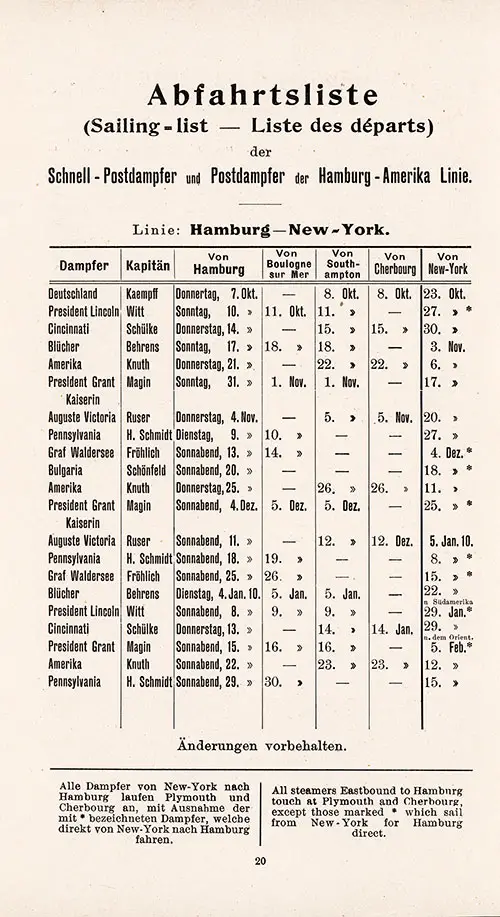
Sailing Schedule, Hamburg-Boulogne sur Mer-Southampton-Cherbourg-New York, from 7 October 1909 to 15 February 1910. Ships Included the Amerika, Blücher, Bulgaria, Cincinnati, Deutschland, Graf Waldersee, Kaiserin Auguste Victoria, Pennsylvania, President Grant, and the President Lincoln. SS Deutschland Passenger List, 7 October 1909. | GGA Image ID # 1e41f7f6aa
Sailing Schedule, European Ports-New York, from 30 April 1910 to 16 November 1910. Ships Included the Amerika, Blücher, Cincinnati, Cleveland, Deutschland, Graf Waldersee, Kaiserin Auguste Victoria, Oceana, Pennsylvania, President Grant, and President Lincoln. NOTE:—All steamers eastbound to Hamburg call at Plymouth and Cherbourg, except the steamer GRAF WALDERSEE, which will sail to Hamburg directly. The steamer PENNSYLVANIA, which will carry Second Class passengers only, will sail directly from New York to Hamburg and from Hamburg to New York. The steamer GRAF WALDERSEE will also carry Second Class passengers only, beginning with her 11 September 1910 sailing from Hamburg. After that date, she will sail directly from and to Hamburg. Hamburg-American Gazette, May 1910. | GGA Image ID # 2128049286. Click to View Larger Image.
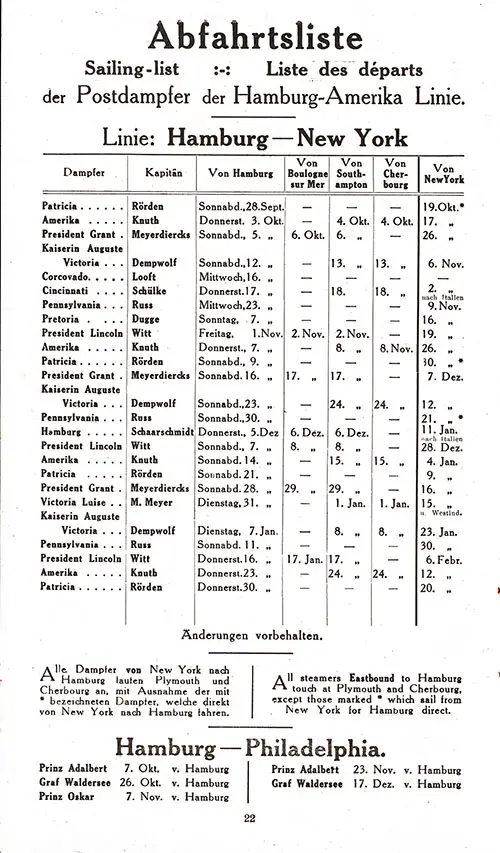
Sailing Schedule, Hamburg-New York via Boulogne-sur-Mer, Southampton, and Cherbourg, from 4 October 1912 to 20 February 1913 and Hamburg-Philadelphia from 7 October 1912 to 17 December 1912. Ships Included the Amerika, Cincinnati, Corcovado, Graf Waldersee, Hamburg, Kaiserin Auguste Victoria, Patricia, Pennsylvania, President Grant, President Lincoln, Pretoria, Prinz Adalbert, Prinz Oskar, and Victoria Luise. Assignment of Ship's Captains Included with Hamburg-New York Ships. SS Patricia Passenger List, 28 September 1912. | GGA Image ID # 1ed91a7f1a
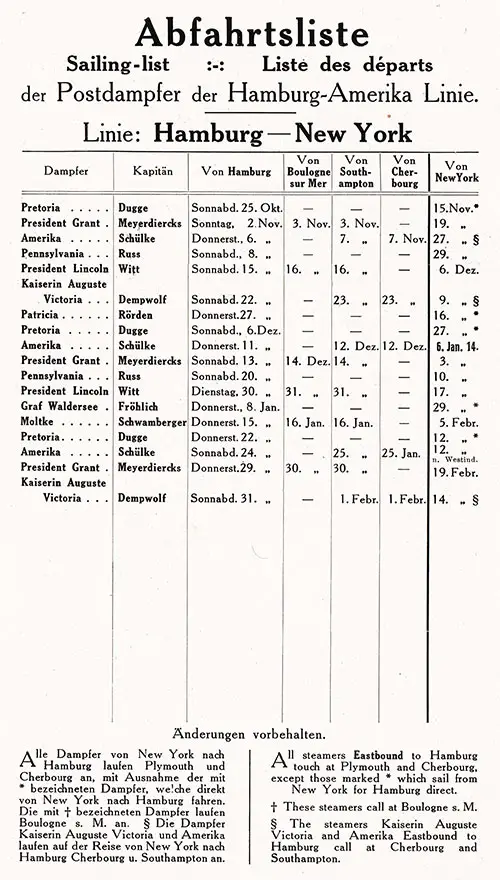
Sailing Schedule, Hamburg-Bologne-Southampton-Cherbourg-New York, from 25 October 1913 to 19 February 1914. Ships Included the Amerika, Graf Waldersee, Kaiserin Auguste Victoria, Moltke, Patricia, Pennsylvania, President Grant, President Lincoln, and Pretoria. SS Pretoria Passenger List, 25 October 1913. | GGA Image ID # 1ee4c20743
Books
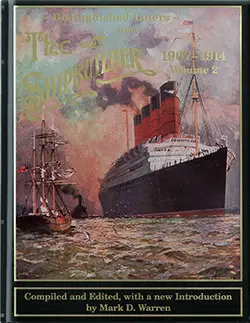
Distinguished Liners from The Shipbuilder - 1907-1914 Volume 2
Distinguished Liners, Volume 2 features 53 famous ships from 1907-1914. Read how the liners were constructed and launched. Lavishly illustrated, each carries many photographs, including the ships, their interiors, machinery, fittings, construction, and launching.
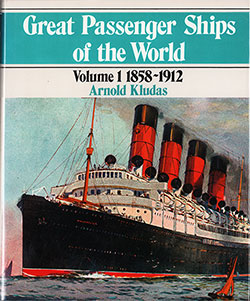
Great Passenger Ships of the World 1858-1912
This initial volume deals with Ships from 1858-1912, from the first passenger ship of over 10,000 GRT to be placed in service (the Great Eastern) to those unforgettable sister ships, the Olympic and Titanic — the first of more than 40,000 GRT.
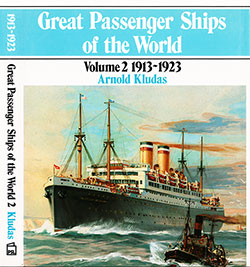
Great Passenger Ships of the World 1913-1923
The period 1913-1923 is dealt with in this second volume. Although it was only a decade, it was one of the most turbulent passenger ships in history. Competition to produce ever-larger vessels declined between leading North Atlantic shipping companies. For 20 years, the ships of the Imperator Class were the largest in the world.

Leviathan: "The World's Greatest Ship" Volume 2
Volume 2 picks up the LEVIATHAN saga during her monumental conversion from a troop ship to a luxury liner and carries the ship’s tempestuous life up through her first round trip as a U.S. express liner. The book finishes with the SS Leviathan's triumphant return to the Atlantic.

Majesty at Sea: The Four Stackers
The opulent and luxurious four-funnel passenger liners, of which only fourteen have ever been built, are unsurpassed in maritime history. Built between 1897 and 1921, these great vessels vied with each other in their standards of comfort, spaciousness, and speed, and great was the rivalry between their owners.

Ocean Steamers: A History of Ocean-Going Passenger Steamships 1820-1970
A history of the steam-powered passenger ship that details its story from the SS Savannah of 1819 to the SS Hamburg of 1969. It contains historical details of all civilian vessels built in the intervening years, with numerous illustrations and previously unpublished material.
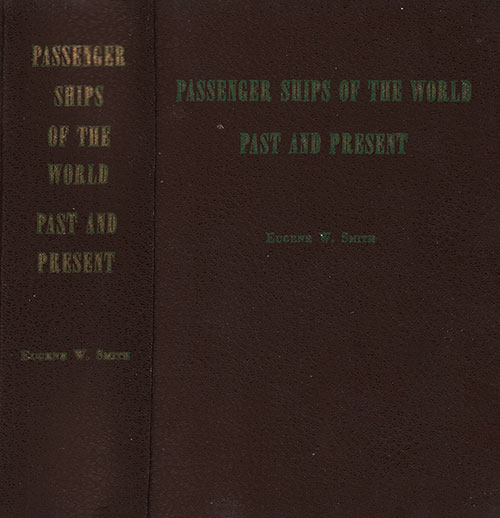
Passenger Ships of the World - 1963
🎓 “A Global Voyage Through Steamship History for Historians, Genealogists, and Maritime Enthusiasts”
Eugene W. Smith’s Passenger Ships of the World – Past and Present (1963) is a masterfully curated encyclopedic reference that charts the rise, peak, and transformation of ocean-going passenger ships through nearly two centuries. Expanding upon his earlier Trans-Atlantic and Trans-Pacific works, Smith offers a global maritime panorama that includes ships serving the Americas, Africa, Europe, Asia, Australia, and Oceania, as well as Canal routes and California-Hawaii shuttle lines.
🧭 This book is an essential resource for:
- Maritime historians seeking design evolution and fleet data
- Genealogists tracing voyages and shipping lines
- Educators and students studying transoceanic migration and tourism
- Ship modelers, naval architects, and enthusiasts interested in dimensions, tonnage, and speed

Pictorial Encyclopedia of Ocean Liners, 1860-1994
One of the most comprehensive pictorial references on ocean liners ever published, this superb chronicle by noted maritime historian William H. Miller, Jr., depicts and describes virtually every passenger ship of over 15,000 tons built between 1860 and the late 1900s.

US Steamships: A Picture Postcard History
Over many years, Postcards were collected for the message, history, and the scene. As a result of these collecting interests, we have a valuable source of information relating to many subjects, including steamships, from a historical, technical, and artistic perspective. The Postcards in this book provide a chronological history of U.S. Steamships.

